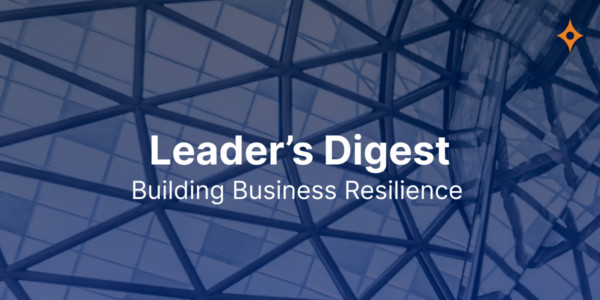14Feb2023
Resilience can be applied in many contexts. Generally, it refers to the ability to withstand or recover from challenges. This applies to individuals who experience a traumatic event, companies that face unprecedented circumstances, and societies going through change and disruption. But what does resilience mean for business and leadership?
We wanted to change things up and do a deep dive into one of our event themes for Nordic Business Forum 2023. Resilience is an important aspect of change, and we felt that it is beneficial for us and our audience to understand it better in a business context. We found some research and literature on the topic and highlighted interesting concepts that came up for developing business resilience in organizations and leadership.
Business Resilience
In the business context, resilience is often defined by a set of characteristics or capabilities. These include survival, vulnerability, recovery, sustainability, performance growth, responsiveness, and development.
Survival refers to a company’s ability to withstand difficult circumstances and remain in business. Vulnerability and responsiveness reflect how well an organization can adapt to changes and complex situations. Recovery encompasses how quickly and effectively a firm can bounce back after taking a hit. Sustainability and performance growth consider a longer time frame. Finally, development describes how a business can find and create new opportunities and capabilities in a challenging environment.
Business resilience generally enables organizations to quickly adapt to disruptions while maintaining their operations. It shows the capacity of an organization to survive, adapt, and grow in the face of change. Therefore, business resilience has become an important quality of organizations and needs to be nurtured to thrive in the challenging business environment. But how can we develop business resilience?
Dynamic Capability
Literature on business resilience has identified operational and dynamic capabilities that drive business resilience. The operational capability focuses on performance growth, whereas the dynamic capability considers other characteristics such as responsiveness, recovery, and development. The dynamic capability of an organization reflects its ability to actively respond to disruptions instead of only bouncing back to a “normal” state after challenges.
Today’s businesses need dynamic capability more than ever before. Nowadays, resilience is more about continuously anticipating, adapting, and thriving in the face of disruptions and improving the capability to change. In practice, dynamic capability shows an organization’s ability to create, expand, or modify its internal and external resources to respond to and possibly shape the rapidly changing business environment. This includes three capacities:
- Sensing – identification and assessment of opportunities and threats
- Seizing – resource mobilization to act on opportunities and to capture the value of actions, including planning the process, choosing the opportunities, and executing the decisions that are made
- Transforming – continuing to develop and update core competencies and reconfiguring resources to meet challenges
An organization needs to develop all three capacities to improve its resilience. To do so, they need competent leadership.
Leadership Competencies for Business Resilience
Entrepreneurial Competence
Studies have found that entrepreneurial competence on all levels of an organization contributes to business resilience, capabilities, and performance. Entrepreneurial competence is a personality value or quality that describes an individual’s creative and innovative ability to find opportunities for success. During times of crisis, entrepreneurial competence enables individuals to respond to challenges, survive, and thrive.
Despite the name, these competencies benefit all organizations and are required from managers and team leaders across the organization. Therefore, entrepreneurial competence should become an institutional value in today’s organizations. It doesn’t only predict resilience but becomes a competitive advantage and leads to sustainable long-term success. It also instills confidence in an individual’s and an organization’s ability to meet challenges and survive crises.
Agile Leadership
Another leadership quality that increases resilience is agility. Agile leadership describes a leader’s ability to be quick, adaptable, and flexible in responding to unforeseen and unfamiliar circumstances. Agile leaders embrace change, collaborate, and think outside the box. Furthermore, agile leadership should also be embraced on all organizational levels, including top executives and managers. This makes organizations more collaborative and able to adapt to change, although implementing the values of agile leadership can be difficult due to its abstract nature. Therefore, leaders must pay close attention to implementing the values in their work and reflect them in practice.
Sustainable Leadership Practices
Finally, sustainable leadership practices enable leaders to ensure the longevity of their teams and businesses. Sustainable leadership requires taking a long-term perspective, fostering systemic innovation, developing a skilled, loyal, and engaged workforce, and offering quality products, services, and solutions. It is also a management approach that aims to deliver better and more sustainable returns, reduce unwanted employee turnover, and accelerate innovation. Sustainable leadership practices enhance performance and increase the prospects of a company’s survival. Some of these practices include:
- Developing people – continuous improvement for everyone
- Ethical behavior – “Doing the right thing” as a core value
- Social responsibility – valuing people and the community
- Team orientation – extensive and empowered teams
- Culture – an enabling and widely shared culture
- Knowledge sharing and retention – spread throughout the organization
- Innovation – strong, systemic, and strategic innovation
- Staff engagement – valuing emotionally committed staff
Pressure to meet short-term goals can hinder an organization’s ability to practice sustainable leadership. However, given that sustainable leadership increases business resilience, ensures long-term success, and increases returns and customer value, it is a practice that should be more widely adopted and benefits businesses and society alike.
Sources:
Muhammedamin Hussen Saad, Geoffrey Hagelaar, Gerben van der Velde & S.
W. F. Omta, 2021. Conceptualization of SMEs’ business resilience: A systematic literature review.
Aldianto, L., Anggadwita, G., Permatasari, A., Mirzanti, I.R.,
Williamson, I.O., 2021. Toward a Business Resilience Framework for Startups.
Avery, G.C. & Bergsteiner, H., 2011. Sustainable leadership practices for enhancing business resilience and performance.
Hidayat, M., Latief, F., Widiawati, A., Asbara, N. W., & Zaeni, N., 2021. Factors Supporting Business and its Distribution to Business Resilience In New Normal Era.

 by:
by: 
